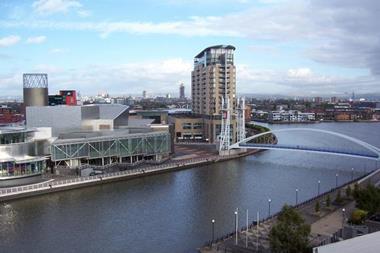Oxygen has sold off its underwriting arm and now has ambitious plans for its broking division. Chief executive Nigel Barton outlines the strategy to Michael Faulkner.
It’s all change at Oxygen. The intermediary sold its underwriting business – a central part of its original business model – to Arthur J Gallagher UK in September. It will now focus on broking.
These are big shifts but Nigel Barton, Oxygen Holding’s chief executive, is matter of fact about the sale: “We were keen to grow further so we sold it.”
Insurance Times meets Barton at the company’s offices in Fenchurch Street near the Tower of London. The reception area and meeting room are adorned with huge photographs of some of the damage caused by hurricane Katrina; flooded roads and wrecked houses. There is a strange beauty to them. “We are in insurance,” says Barton, noticing my interest.
Barton, a flamboyant character with thick-rimmed glasses (he is sporting an unusual pair with black frames that have raised bumps), says the sale has given Oxygen a much stronger balance sheet to focus on its core broking business.
In Oxygen’s four years of trading (see timeline), the broking operation has rapidly outpaced the underwriting business. The latter produced just 20% of the group’s revenues.
“It made sense for someone who wanted to grow it to buy it,” says Barton. “If we could get terms that were right for both parties [we would sell it].”
There was no tender process and Oxygen was in discussion with only two prospective purchasers, he says. US broker Arthur J Gallagher had made no secret of its desire to build its underwriting agency operations. Its offer was accepted and the business, called Oxygen Insurance Managers, was rebranded OIM Underwriting.
Sian Fisher, former boss of Hiscox Insurance, will remain in charge of OIM and the company will continue to operate in the London offices it had shared with Oxygen’s broking business.
“We are not prevented from setting up another underwriting business as long as it does not compete,” says Barton.
He adds that there could be opportunities to place business with OIM, although OIM was writing mainly third-party business before the sale.
Barton says Oxygen is now breaking even and is expected to achieve revenues of £15m to £18m by the end of the year. The business reported a loss in 2007, however (see box, right). “We have broken through the barrier in that all teams are hitting budget.”
“We are now taking a step back to look at business and where to invest,” says Barton. “We are keen to develop specialist services. We’re unlikely to buy businesses, but will hire people.”
Oxygen has made two acquisitions in the past two years: Robertson Taylor, a music and entertainment broker, in September 2007 and Smart & Cook Consulting in 2006.
More recently, Oxygen has been acquiring teams and hiring senior brokers from the London market. In March, it appointed Tom Ernoult, former managing director of Health Lambert National, as managing director of Oxygen Insurance Brokers. In March, it picked up an infrastructure finance broking team of five people from Giles.
Oxygen now has eight offices, including bases in Manchester, Glasgow, Leeds and Bermuda. In September it incorporated a Bermudan company, Oxygen Insurance (Bermuda), led by Graham Wood, former team leader of Gallagher Re’s Bermuda operation.
Barton says the UK retail business will be a key growth area and he plans to hire more staff to boost this part of the operation. “We will look to invest further here. We now have brand [awareness] with corporate customers and we want to raise [that]. The retention rate is in the mid-90s.”
When Oxygen was set up in 2004, its aim was to provide something fresh to the insurance market, an alternative to the major international broking houses.
“Most carriers aren’t happy with the concentration of power in the larger players, exacerbated by the Aon/Benfield merger,” he says. “Over time, we think that should work to our advantage. I still have to win business but, as the market sees green shoots, they will give us encouragement in lots of little ways.”
Barton describes Oxygen as a boutique intermediary. “Oxygen is less grey than other firms; less political, [more] flexible. We are not building a citadel; it is a community of people with shared interest and vision.”
He concedes that Oxygen’s concept had changed since its launch. “Originally, we said we would have the edge in terms of technology, but actually what people want is really good service,” he says. “We are still open to a technological edge, but clients don’t demand it. We are now focusing on service and getting good, entrepreneurial people on board. Clients have to enjoy doing business with us.”
Barton is still searching for different approaches. One idea is to offer Oxygen’s services as a second adviser to risk managers who have already appointed an insurance broker. This is not unprecedented, with listed companies sometimes appointing two corporate brokers to gain extra insights.
Oxygen has already done this successfully with a number of clients, but he concedes that some brokers don’t like being paired with a rival.
“Why wouldn’t a risk manager have another broker provide un-conflicted advice? We wouldn’t take over placement issues,” he says, adding: “But how do you monetise [that service] without losing intellectual property?” IT
Oxygen's results
2007 2006
Turnover £9.1m £4m
Pre-tax loss £3.7m £4.1m
Hosted by comedian and actor Tom Allen, 34 Gold, 23 Silver and 22 Bronze awards were handed out across an amazing 34 categories recognising brilliance and innovation right across the breadth of UK general insurance.









































